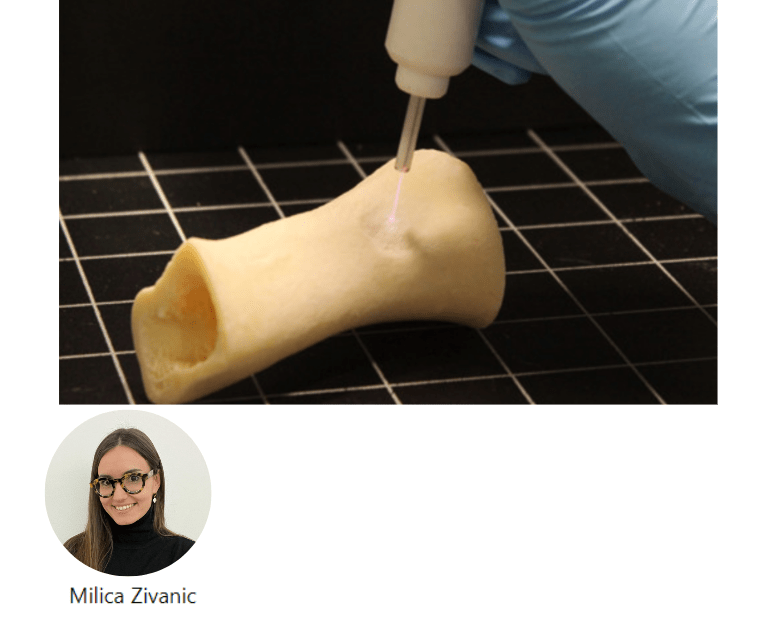
1Biomaterials, Biomechanics and Tissue Engineering Group, Escola d’Enginyeria Barcelona Est and Research Centre for Biomedical Engineering, Universitat Politècnica de Catalunya (UPC), 08019 Barcelona, Spain.
2Plasma Lab for Applications in Sustainability and Medicine-Antwerp (PLASMANT), Department of Chemistry, University of Antwerp, 2610 Antwerp, Belgium.
A cancer treatment written in the stars
If you heat ice it will turn to water. If you keep heating the water it will evaporate and turn into gas. But what happens if you continue heating the gas? Eventually, you will rip electrons from atoms to get gas containing free electrons and ions (charged species). Such ionized gas is called plasma and is a fourth state of matter. Plasma is often found in the universe, e.g., in stars, where high temperatures and pressures are very common. However, scientists have found a way to generate weakly ionized plasma at near-room temperature and atmospheric pressure. Such plasma is called cold atmospheric plasma and is safe to be applied directly to the cells and tissues (Figure 1). In the last decades, cold plasma has found numerous medically relevant uses, from wound healing and disinfection to cancer treatment. The biological activity of plasma mostly comes from the fact that plasma contains so-called reactive oxygen and nitrogen species (RONS), e.g., H2O2, NO2-,… In low concentrations, RONS can act as signaling agents in the cells activating different biological pathways, but in high concentrations, RONS can cause cell damage and death. Due to high metabolic activity, cancer cells have higher baseline levels of RONS compared to healthy cells. This means that when an external source of RONS (such as plasma) is added to the cells, cancer cells are more likely to reach damaging levels of RONS and die than healthy cells. Therefore, plasma has been explored as a cancer therapy with minimal impact on healthy tissue.

Figure 1. (A) Cold atmospheric plasma can be used to directly treat tissues, e.g., for wound healing or cancer applications. (B) Principle of generation of cold atmospheric plasma. (Mateu-Sanz, Tornin et al. 2021).

Figure 2. Mechanisms in which cold atmospheric plasma (CAP) can promote the cancer immunity cycle resulting in anti-tumor immunity (Zivanic, Espona-Noguera et al. 2023).
However, cancer cells are very diverse and, even within the same patient, can respond differently to the same treatment (some cells may survive the treatment). The best way to combat any post-treatment cancer cells is to have anti-tumor immune responses. Immune cells are able to travel throughout the body to kill any remaining or metastatic cancer cells. This ensures durable therapeutic effects. Nevertheless, many cancer cells have strategies to hide from the immune system or suppress immune responses. Therefore, cancer treatments that can increase antigenicity and immunogenicity of tumors, and decrease immunosuppression are very attractive. Cold atmospheric plasma is emerging as such treatment, with different mechanisms that can help activate and enhance anti-tumor immune responses (Figure 2), as discussed in a recent review article : https://doi.org/10.1002/advs.202205803.
Despite its promise, plasma is facing different clinical limitations. Some of the limitations are due to the way in which plasma is applied. Namely, currently, there are two plasma treatment modalities: direct treatment and plasma-treated liquids. In direct treatment, the treatment target is directly exposed to a source of plasma (Figure 1A). This is not very convenient for the (repeated) treatment of internal tumors as it would require surgery.

Figure 3. Current plasma treatment modalities. Adapted from (Zivanic, Espona-Noguera et al. 2023).
On the other hand, plasma-treated liquids are obtained by exposing a clinically relevant liquid to a plasma source to enrich it with long-lived RONS (RONS that are more stable but less potent than short-lived RONS). This liquid can then be injected to treat internal tumors in a non-invasive manner. However, liquids may be quickly diluted and washed away by the body liquids. This may reduce the local concentration of RONS and, thus, therapeutic effects. To overcome these limitations, researchers from PlasmaMedLab within the Department of Materials Science and Engineering (CEM), have started developing plasma-treated hydrogels (Labay, Hamouda et al. 2019, Labay, Roldán et al. 2020, Sole-Marti, Vilella et al. 2022) (Figure 3).
Such hydrogels are obtained by treating the polymeric solution with plasma to enrich it with RONS and then crosslinking it into a hydrogel. Similar to plasma-treated liquids, plasma-treated hydrogels could be injected for a minimally-invasive (and repeated) treatment of internal tumors. But in contrast to plasma-treated liquids, they are more viscous, thus, could remain at the site of injection or implantation for high and prolonged local delivery of RONS. Moreover, they are chemically more complex than liquids, which may lead to interaction with plasma to generate further reactive species or overall enhance the generation or stability of plasma-generated RONS (Labay, Roldán et al. 2020).
Finally, hydrogels may allow to combine plasma technology with tissue-engineering or drug delivery to broaden and improve clinical utility of plasma technology in the future.
References
Labay, C., I. Hamouda, F. Tampieri, M. P. Ginebra and C. Canal (2019). “Production of reactive species in alginate hydrogels for cold atmospheric plasma-based therapies.” Sci Rep 9(1): 16160.
Labay, C., M. Roldán, F. Tampieri, A. Stancampiano, P. E. Bocanegra, M.-P. Ginebra and C. Canal (2020). “Enhanced Generation of Reactive Species by Cold Plasma in Gelatin Solutions for Selective Cancer Cell Death.” ACS Applied Materials & Interfaces 12(42): 47256-47269.
Mateu-Sanz, M., J. Tornin, M. P. Ginebra and C. Canal (2021). “Cold Atmospheric Plasma: A New Strategy Based Primarily on Oxidative Stress for Osteosarcoma Therapy.” J Clin Med 10(4).
Sole-Marti, X., T. Vilella, C. Labay, F. Tampieri, M. P. Ginebra and C. Canal (2022). “Thermosensitive hydrogels to deliver reactive species generated by cold atmospheric plasma: a case study with methylcellulose.” Biomater Sci.
Zivanic, M., A. Espona-Noguera, A. Lin and C. Canal (2023). “Current State of Cold Atmospheric Plasma and Cancer-Immunity Cycle: Therapeutic Relevance and Overcoming Clinical Limitations Using Hydrogels.” Adv Sci (Weinh): e2205803.



